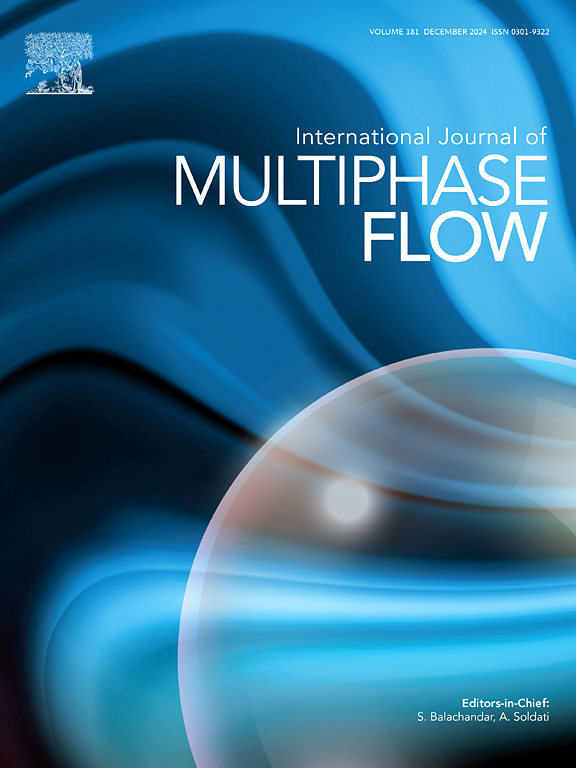Effect of cavitation structures and flow rates on pressure pulsation in the inducer: An experimental investigation
IF 3.6
2区 工程技术
Q1 MECHANICS
International Journal of Multiphase Flow
Pub Date : 2025-04-28
DOI:10.1016/j.ijmultiphaseflow.2025.105272
引用次数: 0
Abstract
The generation of noise and structural vibrations in inducers caused by unsteady cavitation represents a critical technical challenge, necessitating comprehensive investigation into the dynamic characteristics of cavitation-induced pressure pulsations. The method of wavelet decomposition and spectral proper orthogonal decomposition (SPOD) were employed to analyze the connection between instantaneous pressure pulsations and the cavitation structures. The results indicate that hub cavitation and back-flow vortex cavitation occur at 0.6-0.8 ϕd, where ϕd is defined as the flowrate coefficient for which the inducer has been designed. Perpendicular vortex cavitation focuses on 0.8-1.0 ϕd and interacts with the sheet cavitation on the adjacent suction surface. Eddy-cavitation appears at 1.0-1.2 ϕd. However, the tip leakage vortex cavitation area shrinks from a small flow rate to a large one. Cavitation growth primarily induces low-frequency pressure pulsations about 147.5 Hz; cavitation shedding and collapsing at 0.6-0.9 ϕd induces high-frequency pressure pulsations above 636 Hz, whereas 1.0-1.2 ϕd induces low-frequency pressure pulsations below 322 Hz. SPOD analysis of inducer cavitation structures demonstrated decreasing modal spatial sizes with elevated decomposition frequencies and mode orders at constant flow rates, while increased flow rates reduced modal spatial dimensions with constant spectral parameters. The cavitation development process induced a pressure coefficient that increased from valley-to-peak. However, the shedding cavitation migration process generated peak-to-valley pressure transitions.

空化结构和流量对诱导管内压力脉动影响的实验研究
非定常空化引起的诱导体噪声和结构振动是一个关键的技术挑战,需要对空化诱导压力脉动的动态特性进行全面的研究。采用小波分解和谱固有正交分解(SPOD)方法分析了瞬时压力脉动与空化结构之间的关系。结果表明:在0.6 ~ 0.8 μ d范围内出现轮毂空化和回流涡空化,其中μ d定义为诱导轮设计的流量系数。垂直涡空化集中在0.8 ~ 1.0 μ d范围内,与相邻吸力面上的片状空化相互作用。在1.0 ~ 1.2 μ d时出现涡流空化现象。而叶尖泄漏涡空化面积由小流量缩小到大流量。空化增长主要引起约147.5 Hz的低频压力脉动;0.6 ~ 0.9 μ d空化脱落和塌陷引起636 Hz以上的高频压力脉动,而1.0 ~ 1.2 μ d则引起322 Hz以下的低频压力脉动。诱导腔空化结构的SPOD分析表明,在恒定流量下,随着分解频率和模态阶数的增加,模态空间尺寸减小,而在恒定的谱参数下,随着流量的增加,模态空间尺寸减小。空化发展过程导致压力系数从谷到峰逐渐增大。然而,脱落空化迁移过程产生峰谷压力转变。
本文章由计算机程序翻译,如有差异,请以英文原文为准。
求助全文
约1分钟内获得全文
求助全文
来源期刊
CiteScore
7.30
自引率
10.50%
发文量
244
审稿时长
4 months
期刊介绍:
The International Journal of Multiphase Flow publishes analytical, numerical and experimental articles of lasting interest. The scope of the journal includes all aspects of mass, momentum and energy exchange phenomena among different phases such as occur in disperse flows, gas–liquid and liquid–liquid flows, flows in porous media, boiling, granular flows and others.
The journal publishes full papers, brief communications and conference announcements.

 求助内容:
求助内容: 应助结果提醒方式:
应助结果提醒方式:


